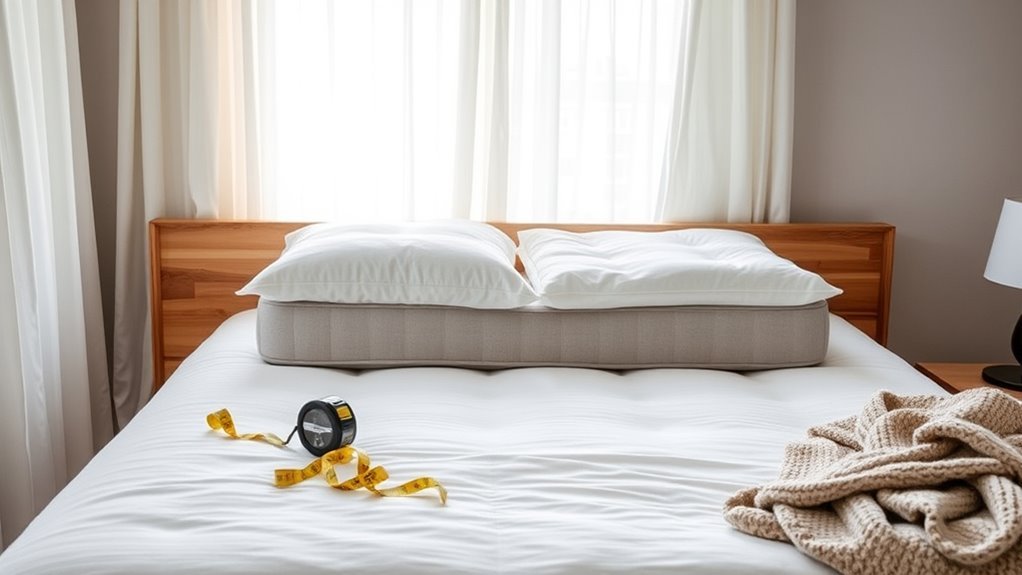If your mattress is causing hip pain, start by evaluating its condition for wear and tear. Examine your sleep position, as proper alignment helps alleviate discomfort. Adding a mattress topper can provide extra support, while adjustable bed frames allow for customizable comfort. Make sure your pillow height supports spinal alignment, and incorporate a strong foundation for added stability. Regular care and maintenance will enhance your sleep environment. Discover additional tips to improve your nighttime comfort.
Assess Your Mattress Condition

Before diving into solutions for hip pain, it’s essential to assess your mattress condition. Start by considering its lifespan; most mattresses last around 7-10 years, and older ones can sag or lose support. Check for visible wear and tear, like lumps or indentations, which can compromise your comfort and alignment. Next, evaluate the material quality. A high-quality mattress made from durable materials will provide better support and adapt to your body’s contours. If you notice discomfort or persistent pain, it might be time to invest in a new mattress. Remember, a good night’s sleep is fundamental for your freedom and well-being, and your mattress plays a significant role in achieving that. Don’t underestimate its impact on your hip health.
Evaluate Your Sleep Position

Since your sleep position can greatly impact hip pain, it’s important to evaluate how you rest at night. If you sleep on your side, placing a pillow between your knees can help align your hips and provide relief. Back sleepers should consider a supportive pillow under their knees, promoting a neutral spine. Stomach sleeping, however, can exacerbate hip pain, so try shifting to another position if that’s your habit. Understanding the sleep position effects on your body is vital for finding effective hip pain remedies. By reviewing your nightly habits, you can make informed adjustments that lead to a more restful sleep and reduced discomfort. Embrace the freedom of pain-free mornings by prioritizing your sleep position now.
Use a Mattress Topper

If you’ve evaluated your sleep position and still experience hip pain, a mattress topper could be the solution you need. These versatile layers come in various mattress materials like memory foam, latex, or gel, allowing you to customize your comfort levels. A topper can enhance support, alleviating pressure on your hips while promoting proper spinal alignment. When selecting a topper, consider your preferred firmness to find the perfect balance between softness and support. This investment not only extends the life of your mattress but also offers a quick fix for discomfort, giving you the freedom to enjoy restful nights. Embracing a mattress topper might just be the key to waking up pain-free and revitalized.
Adjust Your Pillow Height
Adjusting your pillow height can make a significant difference in alleviating hip pain during sleep. The right pillow supports your neck and spine alignment, which directly affects your hips. If your pillow’s too high or too low, it can create tension that radiates to your hips. Experiment with different pillow materials, like memory foam or latex, to find one that complements your preferred sleeping position. Also, consider the pillow firmness; a medium-firm pillow often provides the best balance for support and comfort. Remember, the goal is to maintain a neutral spine while you sleep, allowing your body the freedom to relax and heal. Making these adjustments can lead to a more restful night and less hip pain.
Incorporate a Supportive Foundation
To alleviate hip pain, having a supportive foundation is vital for your mattress. Different types of foundations can provide varying levels of support, so it’s important to choose one that complements your specific mattress type. The right foundation not only enhances comfort but also helps maintain proper spinal alignment, which is key for reducing discomfort.
Importance of Mattress Support
While many people underestimate the role of mattress support, it’s essential for alleviating hip pain and ensuring a restful night’s sleep. A sturdy foundation not only complements your mattress firmness but also enhances your overall sleep quality. Here are four reasons why mattress support matters:
- Proper Alignment: It helps maintain spinal alignment, reducing pressure on your hips.
- Durability: A supportive base extends the life of your mattress, preventing sagging.
- Comfort: It enhances your mattress’s comfort level, allowing you to relax fully.
- Reduced Pain: A solid foundation minimizes discomfort, letting you wake up refreshed.
Investing in the right support can transform your sleep experience, freeing you from pain and enabling rejuvenation.
Types of Supportive Foundations
Choosing the right supportive foundation for your mattress can greatly impact your comfort and overall sleep quality. There are several platform types to take into account, including slatted bases, solid platforms, and adjustable foundations. Each type offers varying levels of support, which can help alleviate hip pain.
Foundation materials also play a significant role—wood, metal, or upholstered options can affect durability and stability. Wooden slats provide excellent ventilation, while solid platforms offer firm, even support. If you’re looking for versatility, adjustable foundations let you customize your sleeping position, potentially reducing pressure on your hips.
Ultimately, selecting the right combination of platform type and foundation material can empower you to achieve the restful sleep you deserve.
Compatibility With Mattress Type
Guaranteeing your mattress is compatible with the right supportive foundation is essential for managing hip pain and enhancing your sleep quality. A mismatched foundation can exacerbate discomfort, so consider these factors:
- Mattress Firmness: Choose a firmness level that balances support and comfort based on your body weight.
- Foundation Type: Guarantee your foundation complements your mattress type; some require solid support, while others can work with slats.
- Weight Distribution: A foundation that evenly distributes your body weight can help relieve pressure points.
- Adjustable Bases: If you prefer flexibility, adjustable bases can provide tailored support for your hips.
Rotate or Flip Your Mattress
If you’re struggling with hip pain, one simple yet effective solution might be rotating or flipping your mattress. Regularly rotating your mattress can help distribute body weight more evenly, minimizing pressure points that could contribute to your discomfort. Here are some rotate benefits and flip techniques to reflect on:
| Rotation Frequency | Benefits |
|---|---|
| Every 3 months | Even wear across surface |
| Every 6 months | Extends mattress life |
| Every 1 year | Enhances comfort levels |
| As needed | Reduces hip pain |
| Flip (if applicable) | Provides fresh support |
Consider Pressure Relief Solutions
After making adjustments to your mattress’s position, it may be time to explore additional strategies for alleviating hip pain. One effective approach is to contemplate pressure relief solutions that cater to your body’s needs. Here are some options to think about:
- Pressure Mapping: Use this technique to identify areas where pressure builds up, helping you make informed decisions.
- Memory Foam Topper: A quality topper can conform to your shape, providing excellent support.
- Latex Materials: Known for their durability and responsiveness, they can help distribute weight evenly.
- Hybrid Mattresses: Combining innerspring and foam can offer the best of both worlds for pressure relief.
Explore Adjustable Bed Frames
Adjustable bed frames can be a game-changer when you’re dealing with hip pain. They allow you to find the perfect position that relieves pressure and enhances comfort, making a significant difference in your sleep quality. Plus, they’re compatible with various mattress types, offering flexibility to suit your needs.
Benefits of Adjustability
While many people overlook the impact of their bed frame on sleep quality, the benefits of adjustability in bed frames can be transformative, especially for those dealing with hip pain. Adjustable bed frames offer:
- Customizable comfort that adapts to your body’s needs.
- Flexible positioning to relieve pressure on your hips and joints.
- The ability to raise your head or feet, enhancing circulation and reducing discomfort.
- Enhanced sleep quality by allowing you to find your perfect angle for relaxation.
Ideal Positions for Comfort
How can you find the perfect position to alleviate hip pain while you sleep? Consider exploring adjustable bed frames, which allow you to customize your sleeping experience. The ideal sleeping positions include sleeping on your back with your knees slightly bent or on your side with a pillow between your legs. These positions promote excellent hip alignment and reduce pressure on sensitive areas. If you’re a stomach sleeper, try adjusting the head of the bed slightly to minimize strain. Experimenting with these positions can make a significant difference in your comfort and overall sleep quality. Remember, it’s all about finding what works best for you, giving you the freedom to enjoy restful, pain-free nights.
Compatibility With Mattress Types
Choosing the right mattress type is essential for maximizing the benefits of an adjustable bed frame, as not all mattresses are designed to flex and bend effectively. To enhance your sleeping experience and alleviate hip pain, consider these factors:
- Material: Memory foam or latex often adapts better to adjustable frames.
- Mattress Firmness: A medium-firm mattress can provide the right support while allowing for flexibility.
- Sleep Temperature: Look for breathable materials to regulate heat, keeping you comfortable throughout the night.
- Weight Distribution: Verify your mattress evenly distributes weight to prevent pressure points.
Finding the right fit can empower you to reclaim restful nights, allowing you to wake up refreshed and pain-free.
Maintain Proper Body Alignment
To alleviate hip pain, maintaining proper body alignment during sleep is important. Your sleep posture plays a significant role in how your body feels each morning. Consider sleeping on your back or side, as these positions help keep your spine aligned. If you’re a side sleeper, placing a pillow between your knees can reduce strain on your hips. For back sleepers, a small cushion under your knees can support your lower back while promoting proper body alignment. It’s essential to choose a mattress that supports your natural curves, allowing for freedom of movement without compromising comfort. By prioritizing your body alignment, you’ll create a restful environment that fosters healing and reduces hip pain, leading to more restorative sleep.
Regularly Clean and Care for Your Mattress
While maintaining proper body alignment is essential for reducing hip pain, the condition of your mattress plays a significant role in your overall comfort and health. Regular mattress cleaning and care can help guarantee a healthier sleep environment, free from allergens and discomfort. Here are some key steps to follow:
- Vacuum regularly to remove dust and debris.
- Use a mattress protector to prevent spills and dust mite infestation.
- Rotate your mattress every three months to promote even wear.
- Spot clean stains with mild detergent to keep it fresh.
Frequently Asked Questions
How Often Should I Replace My Mattress for Optimal Health?
You should replace your mattress every 7 to 10 years for maximum health. Over time, a mattress loses its support, affecting your sleep quality and overall well-being. If you notice discomfort, like hip pain, it might be time for an upgrade. Prioritizing your mattress lifespan guarantees you get the restful sleep you deserve, leading to better energy and freedom in your daily life. Don’t hesitate to invest in your sleep health!
Can Specific Mattress Materials Worsen Hip Pain?
Yes, specific mattress materials can worsen hip pain. For instance, a person named Sarah found that her memory foam mattress, while initially comfortable, caused her hips to sink too deeply, leading to increased pain. In contrast, latex mattresses typically offer better support by providing a responsive surface that keeps your hips aligned. If you’re experiencing discomfort, consider trying a firmer mattress that accommodates your body’s natural curves without sacrificing comfort.
What Signs Indicate My Mattress Is Too Firm or Soft?
If you’re waking up with aches or feeling restless, your mattress firmness might be off. A too-firm mattress can cause pressure points, especially if you sleep on your side, while a too-soft mattress may lead to poor sleep posture, causing your spine to sag. Look for signs like sinking into the mattress or difficulty changing positions during the night. Trust your body; it knows what it needs for restful sleep.
How Does My Weight Affect Mattress Selection for Hip Pain?
Your weight greatly impacts mattress selection, especially for hip pain. Heavier individuals may need a firmer mattress to guarantee proper weight distribution, preventing sinking that can lead to misalignment. Conversely, lighter individuals often benefit from a softer mattress that offers enough give to support their hips. It’s essential to find a balance, as the right firmness can enhance comfort and promote freedom of movement during sleep, reducing the risk of pain.
Are There Specific Exercises to Relieve Hip Pain Caused by Sleep?
Yes, there are specific exercises that can help relieve hip pain caused by sleep. Incorporating stretching techniques like the pigeon pose or hip flexor stretches can improve flexibility and reduce tension. Foam rolling your hip area can also alleviate tightness, promoting better blood flow. Integrating these exercises into your routine can provide relief and help you regain your freedom of movement. Always listen to your body and consult a professional if pain persists.



